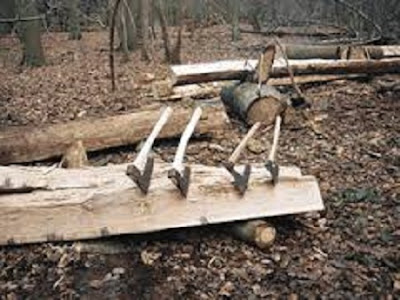A German woodworker cutting a log
into a bar. Note the blue chalk line snapped on the log to which the hewer
lives up to expectations.
In some medieval Scandinavian
structures an extraordinary strategy for cutting which creates a herringbone
design on the timbers has been utilized (Swedish: Slinthuggning, Norwegian:
Sprettejling). This is an advanced recreation in Stråsjö Chapel in Hälsingland,
Sweden.
In carpentry cutting is the
procedure of changing over a log from its adjusted normal structure into (timber)
with pretty much level surfaces utilizing fundamentally a hatchet. It is an
antiquated system still utilized sometimes to square up bars for timber
surrounding.
Cut is a general term intending
to hit or blow with a chainsaw,
for example, a hatchet or sword; to slash or slice, and is utilized as a part
of fighting, stone and wood cutting, and coal and salt mining in this sense.Hewing
wood is to shape the wood with a sharp instrument, for example, an axe,[3]
particularly leveling one or more sides of a log.
Techniques
As an old strategy for timber
change, diverse strategies for every progression in slashing have grown ever.
Plan log
After a tree is chosen and
felled, cutting can happen where the log landed or be slid or jerked (slipped
with a steed or bulls) out of the forested areas to a work site. The log is put
over two other littler logs close to the ground or up on trestles about waist
tallness; balanced out either by indenting the bolster logs, or utilizing a
'timber puppy' (additionally called a log dog,[4] a long bar of iron with a
tooth on either end that sticks into the logs and anticipates development). The
hewer measures and finds the timber inside of the log on both finishes and
imprints lines along the length of a log, as a rule with a chalk line.
Scoring
The following step is to slash
indents each foot or two, as profound as the stamped line utilizing a hacking
or scoring hatchet, called scoring. No less than three routines are utilized as
a part of scoring. 1) Standing on the log and swinging a hatchet to cleave the
score; 2) In Germany a strategy for two craftsmen remaining on the ground with
the log on trestles and swinging descending to cut the scores. (see feature in
connection beneath); 3) A chainsaw is utilized
to indent the log, the segments made by the indenting are then separate from
utilizing a felling hatchet.

No comments:
Post a Comment